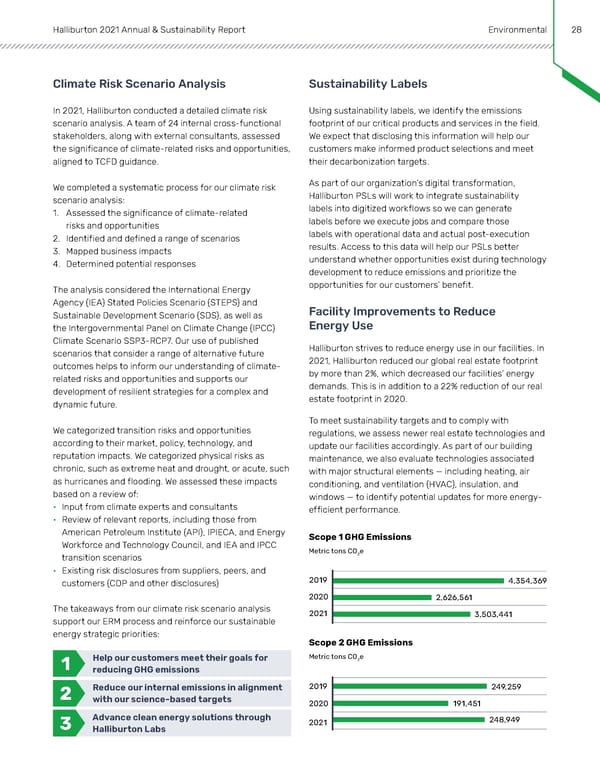Halliburton 2021 Annual & Sustainability Report Environmental 28 Climate Risk Scenario Analysis Sustainability Labels In 2021, Halliburton conducted a detailed climate risk Using sustainability labels, we identify the emissions scenario analysis. A team of 24 internal cross-functional footprint of our critical products and services in the field. stakeholders, along with external consultants, assessed We expect that disclosing this information will help our the significance of climate-related risks and opportunities, customers make informed product selections and meet aligned to TCFD guidance. their decarbonization targets. We completed a systematic process for our climate risk As part of our organization’s digital transformation, scenario analysis: Halliburton PSLs will work to integrate sustainability 1. Assessed the significance of climate-related labels into digitized workflows so we can generate risks and opportunities labels before we execute jobs and compare those 2. Identified and defined a range of scenarios labels with operational data and actual post-execution 3. Mapped business impacts results. Access to this data will help our PSLs better 4. Determined potential responses understand whether opportunities exist during technology development to reduce emissions and prioritize the The analysis considered the International Energy opportunities for our customers’ benefit. Agency (IEA) Stated Policies Scenario (STEPS) and Facility Improvements to Reduce Sustainable Development Scenario (SDS), as well as the Intergovernmental Panel on Climate Change (IPCC) Energy Use Climate Scenario SSP3-RCP7. Our use of published Halliburton strives to reduce energy use in our facilities. In scenarios that consider a range of alternative future 2021, Halliburton reduced our global real estate footprint outcomes helps to inform our understanding of climate- by more than 2%, which decreased our facilities’ energy related risks and opportunities and supports our demands. This is in addition to a 22% reduction of our real development of resilient strategies for a complex and estate footprint in 2020. dynamic future. To meet sustainability targets and to comply with We categorized transition risks and opportunities regulations, we assess newer real estate technologies and according to their market, policy, technology, and update our facilities accordingly. As part of our building reputation impacts. We categorized physical risks as maintenance, we also evaluate technologies associated chronic, such as extreme heat and drought, or acute, such with major structural elements — including heating, air as hurricanes and flooding. We assessed these impacts conditioning, and ventilation (HVAC), insulation, and based on a review of: windows — to identify potential updates for more energy- • Input from climate experts and consultants efficient performance. • Review of relevant reports, including those from American Petroleum Institute (API), IPIECA, and Energy Scope 1 GHG Emissions Workforce and Technology Council, and IEA and IPCC Metric tons CO e transition scenarios 2 • Existing risk disclosures from suppliers, peers, and customers (CDP and other disclosures) 2019 4,354,369 2020 2,626,561 The takeaways from our climate risk scenario analysis 2021 3,503,441 support our ERM process and reinforce our sustainable energy strategic priorities: Scope 2 GHG Emissions 1 Help our customers meet their goals for Metric tons CO2e reducing GHG emissions 2 Reduce our internal emissions in alignment 2019 249,259 with our science-based targets 2020 191,451 3 Advance clean energy solutions through 2021 248,949 Halliburton Labs
 Annual & Sustainability Report | Halliburton Page 26 Page 28
Annual & Sustainability Report | Halliburton Page 26 Page 28